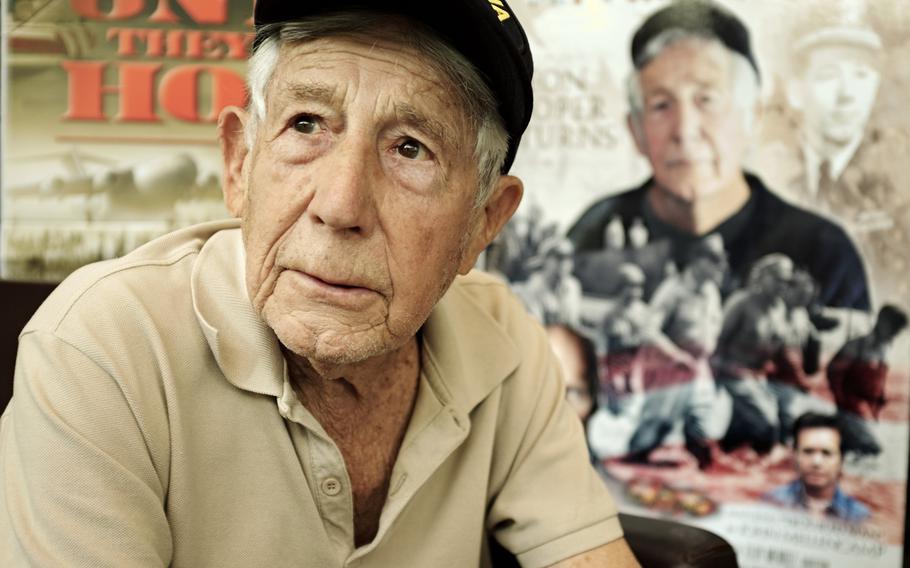
Leon Cooper, a World War II veteran and a Higgins boat commander during the Battle of Tarawa, discusses his life's work of bringing former US prisoners of war home July 28, 2015 in Tokyo, Japan. (James Kimber/Stars and Stripes)
YOKOTA AIR BASE, Japan — If Leon Cooper and Kokichi Nishimura had run into each other during World War II, the result might have been deadly.
When they met in Tokyo in late July, a warm handshake was followed by war stories and talk of their efforts to retrieve the remains of fallen U.S. and Japanese soldiers from remote Pacific battle sites.
Cooper was a Navy lieutenant in command of a group of landing craft called Higgins boats launched from the USS Harry Lee, a passenger ship that carried Marines to some of the toughest battles of the Pacific, including the invasion of New Guinea.
Nishimura was a lance corporal in the Imperial Japanese Army’s South Seas Detachment and participated in the invasion of Guam before fighting in New Guinea.
“I was very moved by a guy who was my mortal enemy at one time,” Cooper, 95, said after visiting Nishimura, also 95, at a Tokyo hospital. “If he and I had met during the war in New Guinea, one of us would have been killed or at least seriously hurt by the other.”
Cooper was in Japan with Los Angles documentary filmmakers Steve Barber and Matthew Hausie. The trio are visiting the sites of six major battles that Cooper fought in during World War II. They’ve been to Tarawa and the Philippines and plan to visit Guam, Iwo Jima, Kwajelein and the Gilbert Islands.
In New Guinea, Nishimura fought on the Kokoda Trail where the Japanese engaged in a series of deadly skirmishes with Australians in an effort to take Port Moresby. Shot three times, he was the lone survivor in a 56-man platoon that was wiped out in the Battle of Brigade Hill, according to the 2008 book “Kokoda Bone Man” by Australian journalist Charles Happell.
Meanwhile, Cooper was landing Gen. Douglas MacArthur’s forces on New Guinea at Hollandia and Aitape in an effort to cut off supplies for Japanese troops. He hasn’t been back since but plans to go there on his next trip.
He’ll be following in Nishimura’s footsteps. Motivated by stories of Japanese troops who refused to believe that their nation had surrendered and survived in the jungle for decades, he spent eight years searching for the remains of those who went missing in action.
Nishimura retrieved numerous sets of remains earning him the nickname “Bone Man of Kokoda,” Cooper said.
The meeting between the two old warriors was emotional.
“I offered my hand in friendship, respect and admiration for a man who, like me, wanted to do more to have his country understand what these guys had done,” Cooper said.
He got interested in repatriating the remains of lost war dead after a 2007 visit to the site of his first battle — Tarawa. His goal at the time was to get trash cleared from the beach where he landed Marines in 1943, but islanders told him about the graves of unidentified Marines and sailors, he said.
That first trip was chronicled by Barber and Hausie in “Return to Tarawa: The Leon Cooper Story,” a 2009 documentary narrated by actor Ed Harris.
The filmmakers went back in 2008 with the Joint POW/MIA Accounting Command and made “Until they Are Home,” narrated by Kelsey Grammer, about the recovery of two sets of remains from Tarawa.
The search for remains on the island — where hundreds of U.S. troops are believed to be buried — bore fruit last month with the return of 39 sets of remains, including those of Medal of Honor recipient Alexander Bonnyman Jr., to the U.S.
Cooper said it’s now his calling to search for other MIAs in the Pacific.
“More of our guys lie in unmarked graves in the Pacific than in Europe where battles were in areas with urban populations,” he said.
Last year Barber and Hausie took Cooper to the Philippines to search for remains and made a documentary called “Return to the Philippines,” also narrated by Harris.
Cooper said he’s frustrated with what he sees as the Defense Department’s lack of effort to find servicemembers lost overseas and its failure to test the DNA of thousands of U.S. troops buried as unknowns in Manila.
The trio talked to volunteers searching for remains of servicemembers there but, Barber said, they got little help from the U.S. and Philippines governments. There’s an agreement between the two nations to facilitate the search for soldiers lost in the war, but neither side appears to be actively looking for them, he said.
Barber said he’s inspired by Cooper’s efforts.
“Leon is the last U.S. WWII vet in the fight,” he said. “There are a lot of World War II vets still alive, but he’s doing things that no other person his age can do.”
Air Force Maj. Natasha Waggoner, a spokeswoman for the Defense POW/MIA Accounting Agency, said in an email Friday that there are over 3,000 graves with unknown servicemembers in the Manila American Cemetery.
In April, Defense Secretary Ash Carter defined thresholds that must be met before disinterment of a grave can happen. These include compiling a list of missing servicemembers who could be among the unknowns and collecting medical and dental records and family DNA samples that may help identify the dead.
“DPAA is actively researching and working on meeting the thresholds that have been outlined so we can disinter these individuals,” Waggoner said.
Stars and Stripes staffer Wyatt Olson contributed to this report.
Twitter: @SethRobson1